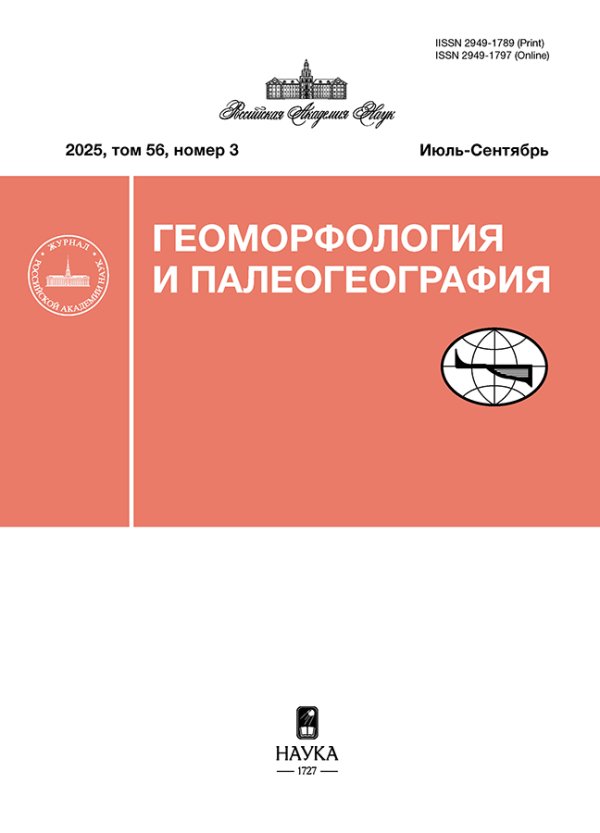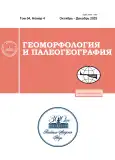TRANSFORMATION OF PLANT COMMUNITIES AT THE TURN OF THE PLEISTOCENE AND HOLOCENE IN THE ROSTOV LOWLAND (YAROSLAVL REGION)1
- Authors: Samus A.V.1, Konstantinov E.A.1, Borisova O.K.1, Lazukova L.I.1
-
Affiliations:
- Institute of Geography RAS
- Issue: Vol 54, No 4 (2023)
- Pages: 163-178
- Section: Paleolimnological research in Russia: from Kaliningrad to Kamchatka
- URL: https://journals.rcsi.science/2949-1789/article/view/232945
- DOI: https://doi.org/10.31857/S2949178923040114
- EDN: https://elibrary.ru/HUJZCX
- ID: 232945
Cite item
Full Text
Abstract
The article presents the results of a multiproxy study of a sedimentary sequence located on the lacustrine-alluvial plain west of Lake Nero (Yaroslavl region). The investigated 2 m-long core made it possible to reconstruct environmental changes since the Allerød to the Late Holocene. Previously poorly studied Preboreal deposits in this area have a significant thickness in the core (0.4 m). The obtained materials help fill the gap in understanding of the vegetation history in the Rostov lowland at the turn of the Late Glacial and Holocene and during the Early Holocene. The study is based on several paleogeographic methods: spore-pollen analysis, botanical composition analysis of peat, diatom analysis, loss-on-ignition, and radiocarbon dating. It was found that after 14.3 cal. ka BP sparse spruce-birch forests were widespread, open spaces were occupied by herbaceous communities. Since 13.7 cal. ka BP, as a result of a significant cooling, the open areas expanded, sparse birch forests dominated in combination with steppe and tundra associations. About 12.1 cal. ka BP a lowland reed wetland began to form at the site. It transformed into a reed-sedge wetland after 10.9 cal. ka BP. During the interval of 12.1–11.5 cal. ka BP, the landscapes of the periglacial forest-steppe were gradually replaced by pine-birch forests. The climate was colder than today, but with the tendency to warming compared to the Late Glacial stage. Short-term cooling 11.5–11.2 cal. ka BP led to a new expansion of open herbaceous communities, but the spread of forests continued after 11.2 cal. ka BP. Starting from 9.8 cal. ka BP, the role of broadleaf species increased in the woods; mixed pine-birch forests with oak, elm, and linden dominated in the surrounding area. In the interval 7.9–5.2 cal. ka BP, climate conditions were warmer than modern ones. This led to the spread of spruce-pine forests with birch and thermophilous deciduous trees. After 5.2 cal. ka BP the vegetation cover was dominated by spruce forests with pine, birch, and broadleaf species.
About the authors
A. V. Samus
Institute of Geography RAS
Author for correspondence.
Email: avsamus@igras.ru
Russia, Moscow
E. A. Konstantinov
Institute of Geography RAS
Email: avsamus@igras.ru
Russia, Moscow
O. K. Borisova
Institute of Geography RAS
Email: avsamus@igras.ru
Russia, Moscow
L. I. Lazukova
Institute of Geography RAS
Email: avsamus@igras.ru
Russia, Moscow
References
- Aleshinskaya Z.V., Gunova V.S. (1975). Holocene history of Lake Nero by record of multiple methods. Istoriya ozer v golotsene. L.: Rotaprint GO SSSR (Publ.). P. 150–158. (in Russ.)
- Aleshinskaya Z.V., Gunova V.S. (1997). The newest sediments and paleogeography of Lake Nero. Vestnik Mosk. un-ta. Ser. 5. Geografiya. No. 1. P. 49–52. (in Russ.)
- Battarbee R.W., Jones V.J., Flower R.J. (2001). Diatoms. Tracking Environmental Change Using Lake Sediments. Vol. 3: Terrestrial, Algal and Siliceous Indicators. P. 155–202. http://doi.org/10.1007/0-306-47668-1_8
- Bikbulatov E.S., Bikbulatova E.M., Litvinov A.S., Poddubnyi S.A. (2003). Gidrologiya i gidrokhimiya ozera Nero (Hydrology and hydrochemistry of Lake Nero). Rybinsk: Rybinskiy dom pechati (Publ.). 192 p. (in Russ.)
- Bobrov A.E., Kupriyanova L.A., Litvintseva M.V., Tarasevich V.F. (1983). Spory paporotnikoobraznykh i pyl’tsa golosemennykh i odnodol’nykh rastenii flory evropeiskoi chasti SSSR (Spores of ferns and pollen of gymnosperms and monocots of the flora of the European part of the USSR). Leningrad: Nauka (Publ.). 208 p. (in Russ.)
- Borisova O., Konstantinov E., Utkina A. et al. (2022). On the existence of a large proglacial lake in the Rostov-Kostroma lowland, North-Central European Russia. Journal of Quaternary Science. P. 1–18. http://doi.org/10.1002/jqs.3454
- Borisova O.K., Naryshkina N.N., Konstantinov E.A., Panin A.V. (2022). Landscape and climate changes in the Preboreal in the Northwestern European Russia. Geomorfologiya. Vol. 53. No. 3. P. 19–28. (in Russ.) http://doi.org/10.31857/S0435428122030051
- Bronk Ramsey C. (2009). Bayesian analysis of radiocarbon dates. Radiocarbon. No. 51 (2). P. 337–360. http://doi.org/10.1017/S0033822200033865
- Ditmar A.B., Voskoboinikova S.M., Ivanov A.N. et al. (Eds.). (1964). Atlas Yaroslavskoi oblasti (Atlas of the Yaroslavl region). Moscow: GUGK (Publ.). 28 p. (in Russ.)
- Geologicheskaya karta chetvertichnykh otlozhenii masshtaba 1:200 000. List O-37-XXVIII. (1967). (Geological map of Quaternary deposits on a scale of 1:200 000. Sheet O-37-XXVIII). Leningrad: VSEGEI (Publ.). (in Russ.)
- Grichuk V.P., Zaklinskaya E.D. (1948). Analiz iskopaemykh pyl’tsy i spor i ego primenenie v paleogeografii (Analysis of fossil pollen and spores and its application in palaeogeography). Moscow: OGIZ (Publ.). (in Russ.)
- Grimm E.C. (1987). CONISS: A FORTRAN 77 program for stratigraphically constrained cluster analysis by the method of incremental sum of squares. Computers & Geosciences. Vol. 13. P. 13–35.
- Grimm E.C. (1990). TILIA and TILIA*GRAPH.PC spreadsheet and graphics software for pollen data. INQUA, Working Group on Data-Handling Methods, Newsletter. Vol. 4. P. 5–7.
- Gunova V.S. (1975). Istoriya ozera Nero po paleobotani-cheskim dannym (History of Lake Nero according to palaeobotanical data). PhD thesis. Moscow: MSU. 21 p. (in Russ.)
- Gunova V.S., Leflat O.N. (1997). Holocene and modern state of the Lake Nero ecosystem. Vestnik Mosk. un-ta. Ser. 5. Geografiya. No. 4. P. 42–45. (in Russ.)
- Khomutova V.I., Davydova N.N., Raukas A.V., Rumyantsev V.A. (Eds.). (1998). Istoriya ozer SSSR. Istoriya pleistotsenovykh ozer Vostochno-Evropeiskoi ravniny (History of the USSR lakes. The history of pleistocene lakes of the East European plain). Saint Petersburg: Nauka (Publ.). 406 p. (in Russ.)
- Khotinskii N.A. (1977). Golotsen Severnoi Evrazii (Holocene of the Northern Eurasia). Moscow: Nauka (Publ.). 200 p. (in Russ.)
- Kobashi T., Severinghaus J., Barnola J.-M. (2008). 4 ± 1.5°C abrupt warming 11,270 yr ago identified from trapped air in Greenland ice. Earth and Planetary Science Letters. Vol. 268. No. 3. P. 397–407. http://doi.org/10.1016/j.epsl.2008.01.032
- Konstantinov E.A., Karpukhina N.V., Zakharov A.L. et al. (2023). Fluctuations of Lake Nero in the Holocene. Geomorfologiya i Paleogeografiya. Vol. 54. No. 2. P. 51–60. (in Russ.). http://doi.org/10.31857/S2949178923020044
- Korde N.V. (1960). Biostratifikatsiya i tipologiya russkikh sapropelei (Biostratification and classification of Russian sapropels). Moscow: AN SSSR (Publ.). 220 p. (in Russ.)
- Kupriyanova L.A., Aleshina L.A. (1978). Pyl’tsa dvudol’nykh rastenii flory evropeiskoi chasti SSSR (Pollen of dicotyledonous plants of the flora of the European part of the USSR). Leningrad: Nauka (Publ.). 184 p. (in Russ.)
- Kupriyanova L.A., Aleshina L.A. (1972). Pyl’tsa i spory rastenii flory evropeiskoi chasti SSSR. T. 1 (Pollen and spores of flora of the European part of the USSR. Vol. 1). Leningrad: Nauka (Publ.). 171 p. (in Russ.)
- Mazei N.G., Novenko E.Yu. (2021). The use of propionic anhydride in the preparation of samples for pollen ana-lysis. Nature Conservation Research. Zapovednaya Nauka. No. 6 (3): 110–112. (in Russ.) http://doi.org/10.24189/ncr.2021.036
- Panin A., Matlakhova E. (2015). Fluvial chronology in the East European Plain over the last 20 ka and its palaeohydrological implications. Catena. No. 130. P. 46–61. http://doi.org/10.1016/j.catena.2014.08.016
- Pochvy Rostovskogo raiona Yaroslavskoi oblasti i recommendatsii po ikh ispol’zovaniyu. (1988). (Soils of the Rostov region (Yaroslavl oblast) and recommendations for their use). Leningrad: LGU (Publ.). 223 p. (in Russ.)
- Stockmarr J. (1971). Tablets with spores used in absolute pollen analysis. Pollen et Spores. Vol. 13. P. 614–621.
- Sudakova N.G., Dashevskij V.V., Pisareva V.V. (1984). Quaternary deposits of the environs of the city of Rostov Yaroslavsky. Putevoditel’ ekskursii 10-V XXVII Mezhdunarodnogo geologicheskogo kongressa. Moscow: Soyuzgeolfond (Publ.). 26 p. (in Russ.)
- Wohlfarth B., Lacourse T., Bennike O. et al. (2007). Climatic and environmental changes in north-western Russia between 15000 and 8000 cal yr BP: a review. Quat. Sci. Rev. Vol. 26. P. 1871–1883. https://doi.org/10.1016/j.quascirev.2007.04.005
- Wohlfarth B., Tarasov P., Bennike O. et al. (2006). Late glacial and Holocene palaeoenvironmental changes in the Rostov–Yaroslavl area, West Central Russia. Journal of Paleolimnology. Vol. 35. 543–569. http://doi.org/10.1007/s10933-005-3240-4
Supplementary files

















